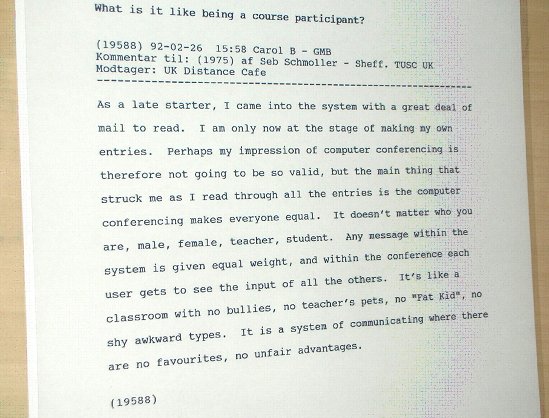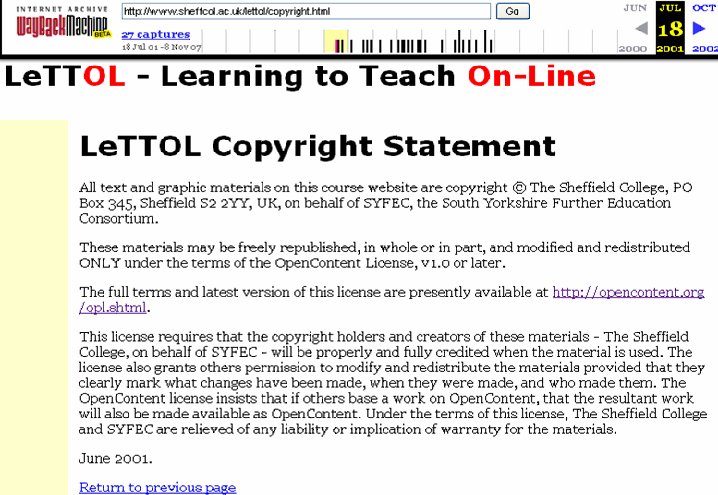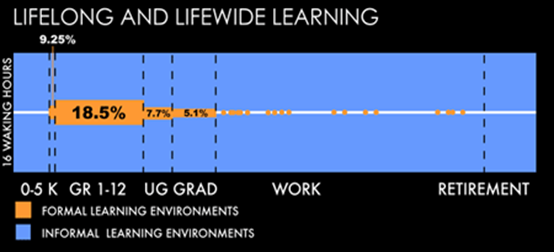Seb Schmoller Replies
Stepping down from his pivotal role as CEO at ALT, Seb Schmoller kindly answers a few questions from Ariadne on his perspective on online learning.
Ariadne: Seb, please tell us a little about yourself.
I’ve lived in the same house in Sheffield since 1976, having moved here from London via Cambridge in 1975. Between 1978 and 2002 I worked in Further Education. I did two main things. Between 1978 and 1996 I mainly ran and developed courses for trade union representatives under the auspices of the TUC Education Service. Between 1996 and 2002 when I was made voluntarily redundant in a reorganisation, I was The Sheffield College’s Learning Technology Development Manager, responsible with others for developing Learning To Teach On-Line (LeTTOL) [1], an early online course about how to be on online tutor. I then combined independent work and half-time employment with the Association for Learning Technology (ALT) [2] for nearly 10 years from 2003 until May this year, when, having hit 60, I decided to take my teacher’s pension and become a bit more of a free agent.
Ariadne: How did you first come to be involved in online learning?
I bought a two floppy disk Amstrad PCW in 1985 mainly for word-processing, and for trade union work. (I was very involved in my union NATFHE, and in what was at that time known as the “hazards movement”, campaigning for better regulation of occupational safety health and supporting workplace trade union representatives who deal with the hazards of work.) In the early 1990s I was fortunate to be asked by the TUC to run the UK end of a European project called TUDIC. The aim of TUDIC, which was led by LO Denmark with LO Sweden (each the equivalent of the TUC) and UNI?C [3](which played a similar role to JISC in the UK), was to use “computer conferencing” in the creation and then running of an online course for trade union representatives about European integration. This was my first exposure to working online and to online distance education.
Ariadne: One recalls the struggles of other educators with early ICT that was never designed to meet their requirements. How user-friendly was yours, and how did you and your students cope?
For TUDIC we used a conferencing system called PortaCOM, originally developed by the Swede Jacob Palme [4]. The nice thing about it was that UNI?C [3] provided us with some handy client software (called BettyCom) which handled the otherwise tortuous login process, and which provided a well-organised front-end to PortaCOM through which users interacted with PortaCOM. What’s more, BettyCOM created for the user a local archive of messages, which allowed users to work off line. This entirely got away from the need for users to work from a command line interface, which was common in many other conferencing systems from that time.
Ariadne: What sort of online learning was there before there was the Web?
Yes, these were pre-web days. If you worked in a university you might have had a networked PC on your desk, which might have been connected to the Internet. In homes and ordinary workplaces, connected PCs were rare, and getting online was complicated and very expensive. In the case of TUDIC, we each connected through a 2400 Baud modem to a “point of presence” (in our case the point of presence – for all the UK learners - was a BT phone line in Rotherham). There being no Web, there was not the mass of learning resources “out there”. Online learners had to rely on what they themselves created, on paper-based materials, and on texts provided as part of their course.
Ariadne: Despite, to newcomers’ eyes, the limited capabilities at that time, what prompted you to get so involved in online learning?
I became sold on it because I could see how productive even a primitive system of the kind described was for learners; how much effort being an online learner engendered, and how enthusiastic learners were for the medium. And though with hindsight I can see that what we had was primitive, it did not seem so at the time.

Figure 1: Content from the pre-Web online course for shop stewards in Denmark, Sweden, and the UK about European integration in a posting on our PortaCOM Conferencing System
Ariadne: With the benefit of hindsight, how important do you feel the LeTTOL Project was to the development of online learning?
I’m not the best person to answer this question, and to the best of my knowledge there’s been no empirical work done on the impact of LeTTOL course, apart from an evaluation that we commissioned in 2001 from Adam Warren at the University of Southampton [5]. It was an unusual course for that time, and not just for FE, since it had tutors in the UK, Australia, and Canada, together with a proper case-loading system where tutors were paid or given time according to the number of learners they were supporting. A large number of people undertook it, from all over the world, and it still runs, albeit on a much smaller scale than during the early 2000s. And The Sheffield College has made a particular success of applying the LeTTOL approach to the design of online courses to a wide range of courses from NVQ level 1 to 5. A recent example includes the College’s recently launched course entitled “Human Trafficking Uncovered” [6].
Ariadne: How does Open Content fit into the development of online learning in your view?
It depends on what you mean by Open Content. In point of fact LeTTOL used David Wiley’s Open Content licence [7] almost from the start, and the absence of imitators taught me that it is not the content but the process of running an online course that is where an organisation’s main IP resides. Moreover, despite the success of LeTTOL, as far as I know no-one reused the content, though they could have done, convincing me that the risks of “going Open” are misunderstood as well as over-stated. Of course the world has changed since the late 1990s and the obvious point to make is that the Web as a content-rich searchable open environment for learning makes the learning resources side of course design much more straightforward, with the focus needing to be more on the design of learning activities than on the instructional content. (An exception here might be in the design of courses that rely on carefully structured sequences of instructional video or context-related explanation which are likely to need creating from scratch.)

Figure 2: Copyright statement from the LeTTOL course
Ariadne: How important in your view has been the role of the Association for Learning Technology in the evolution of online learning?
I’ve been too closely involved in ALT for too long to have any kind of objective view about this, so I will pass on this one.
Ariadne: What do you consider to be the most important things you have learned in your work in this field?
I would say:
- Concentrate on process more than on content.
- Iterate. This means that you should not separate content creation from running courses, and that you need to use feedback from courses in use to influence future versions of a course.
- Understand that it is the learners who have to do the learning. Two powerful quotes support this:
1) Learning is inherently lifelong and life-wide:

Figure 3: Learning is life-wide and lifelong
This diagram by Professor Roy Pea at Stanford elegantly demonstrates how, from a citizen’s point of view, such a tiny proportion of life is spent in a formal learning environment, and how relatively more important (in terms of available time) is the informal learning environment.
and in contrast to models such as this:
![Figure 4: ADL and the Sharable Content Object Reference Model [8] Figure 4: ADL and the Sharable Content Object Reference Model [8]](/images/issue70-schmoller/figure4-reference-model.png)
Figure 4: ADL and the Sharable Content Object Reference Model [8]
2) Unlike pizza, learning cannot be delivered.
Instead we must at all times remember that effort by learners is a necessary but insufficient condition for learning, and that it is learners not teachers that create learning. For me these further two quotes serve as touchstones; the first is:
Learning results from what the student does and thinks and only from what the student does and thinks. The teacher can advance learning only by influencing what the student does to learn. Herb Simon
while the second occurred during the 2007 ALT Conference:
.. the big trap is that teachers do not create learning. That’s true—teachers do not create learning, and yet most teachers behave as if they do. Learners create learning. Teachers create the conditions under which learning can take place. Dylan Wiliam
I think this perspective is very important when thinking about the role of markets and the private sector in education, since markets tend to work well where the value of what is bought is clear at the start. That is simply not the case where learning is concerned, since the value of your learning depends on you. Separately there are broader issues about the responsibilities of the state to ensure that citizens are educated, and the unsuitability of the market to ensure this.
Finally:
- Strive to innovate with an eye on the steady state funding that will be available if your innovation is successful, rather than with an eye on the next grant.
Ariadne: What in your view have been the most successful developments in online learning over recent years, whether they are technical organisational in nature, or indeed something else?
Peter Norvig’s and Sebastian Thrun’s mass online AI course was for me a complete eye-opener. The very striking thing about the course (which I know because I spent five to 10 hours a week for 10 weeks as one of its students last year) was that despite its 160,000 enrolments, 50,000-plus active students and 20,000 completers, the course made us learners feel that we were receiving one-to-one instruction from Norvig and Thrun. As Rob Rambusch, a fellow student of mine, put it: "The class felt like sitting in a bar with a really smart friend who is explaining something you haven't yet grasped but are about to." The course engendered focused and mass engagement in learning at extremely low cost. It is this above all that justifies the attention that MOOCS and other large-scale learning technologies are now getting.
Ariadne: Whom do you consider the most influential contributors to this field?
Placing them in no particular order other than alphabetical, I would suggest:
- Donald Clark (for his iconoclastic and challenging melding of learning theory with practical and business-related insights);
- Stephen Downes: because of the extraordinary way in which he has steadily and systematically documented and played a part in initiating developments in our field;
- John Daniels: for continuing to contribute profound insights into how to organise Higher Education, world-wide, at scale;
- Diana Laurillard: because of her book Rethinking University Teaching and her more recent work on teaching as a design science;
- Robin Mason RIP: for doing a lot of the ground-work about online distance learning – see, for example her and Tony Kaye’s 1990 Mindweave – Communication, Computers and Distance Education;
- Eric Mazur: for managing to combine leadership in a theoretical field with leadership in the teaching of that field, with public work to change for the better teaching and learning more generally;
- Sugata Mitra: because of the continuous freshness of his thinking, and for his focus on the learning not the teaching;
- Peter Norvig: because of the open and accessible way in which he makes hard-core computer science intelligible to the layperson;
- Diane Ravitch: for her tireless defence of the underlying principle that education is a public good;
- Larry Sanger and Jimmy Wales: for bringing Wikipedia to fruition;
- Aaron Sloman: for his work on computational thinking;
- Sherry Turkle and Jaron Lanier: for challenging – from different perspectives – the assumptions that are made about technology as a force for good;
- Sebastian Thrun: for having had the ‘bottle’, with Peter Norvig, to envisage and then create the ‘Stanford’ online AI course;
- Audrey Watters: because of how she astutely mixes the technical, political, business and personal in her writing about learning technology;
- David Weinberger: because he understood so early the way that the Web would affect how we organise and access information, writing about it with wit and clarity;
- Dylan Wiliam: for his work on formative and summative assessment, and on strategies and methods to improve learning more generally.
Ariadne: As you step away from all your work with ALT, how do you see the shape of online learning at the present moment?
I think that the take-off of MOOCs and the interest they have generated has finally put online learning – and hence the Learning Technology field – centre-stage in thinking about the long-term future and structure of publicly available education.
Ariadne: Do you consider that MOOCs realistically represent a major improvement in the education chances of people in developing countries with basic connectivity – or is this just hype?
Yes, undoubtedly, as some of the stories told by Sebastian Thrun about learners in, say, Pakistan, demonstrate. Clay Shirky has also recently written persuasively about this issue from the angle of how MOOCs represent a major improvement in the education chances of people who would otherwise attend a not very illustrious college:
In the US, an undergraduate education used to be an option, one way to get into the middle class. Now it’s a hostage situation, required to avoid falling out of it. And if some of the hostages having trouble coming up with the ransom conclude that our current system is a completely terrible idea, then learning will come unbundled from the pursuit of a degree just as as songs came unbundled from CDs.
If this happens, Harvard will be fine. Yale will be fine, and Stanford, and Swarthmore, and Duke. But Bridgerland Applied Technology College? [9]
Ariadne: What do you consider to be the chief difficulties currently confronting institutions in respect of online learning?
Doing things at a big enough scale to be cost-effective and in a way that does not involve parallel invention of the same wheel in many places at once.
Ariadne: Finally, Seb, if we asked you to place the developments in your field in the context of the history of publishing and scholarly endeavour, what degree of importance would you attach to it?
When we look down at the surface of the road we are on we are so close to it that it rushes past in a blur, making it impossible easily to judge what is important. But if you stand back you can see that the ‘Internet and computing revolution’ is now affecting profoundly the formal and informal learning of hundreds of millions of people, despite the fact that it is only 20 years since the invention of the Web. At the same time – and the diagram below attempts to illustrate this – we are talking about an extremely recent phenomenon within the overall sweep of human history.
![Figure 5: My diagram prompted by a discussion of a thought experiment by the biologist John Maynard Smith in The Craftsman by Richard Sennett. [10] Figure 5: My diagram prompted by a discussion of a thought experiment by the biologist John Maynard Smith in The Craftsman by Richard Sennett. [10]](/images/issue70-schmoller/figure5-timescale.jpg)
Figure 5: My diagram prompted by a discussion of a thought experiment by the biologist John Maynard Smith in The Craftsman by Richard Sennett. [10]
So for the moment we’ll have to live with the contradiction that: 1) it is far too early to say; and 2) developments in the learning technology field are very profound.
References
- LeTTOL at The Sheffield College http://www.online.sheffcol.ac.uk/index.cfm?ParentID=7f6d8400-59f1-45ae-b10d-03b0b3f97d8b
- About the Association for Learning Technology (ALT) http://www.alt.ac.uk/about-alt
- UNI•C, The Danish IT Centre for Education and Research http://www.uni-c.dk/generelt/english/
- Jacob Palme. History of the KOM Computer Conferencing System, First version May 1990. Latest revision: 22 October 2000 http://people.dsv.su.se/~jpalme/s1/history-of-KOM.html
- Adam Warren."An evaluation of the LeTTOL course". 7 February 2001 http://schmoller.net/documents/LeTTOL_evaluation_by_Adam_Warren_2001.pdf
- Human Trafficking Uncovered, The Online College, The Sheffield College, July 2012
http://www.online.sheffcol.ac.uk/index.cfm?pid=d4222c09-7b8d-452c-9121-0e8173874946 - OpenContent: OpenContent License (OPL) Version 1.0, July 14, 1998 http://web.archive.org/web/19990129013417/http://www.opencontent.org/opl.shtml
- Source of Figure 4: ADL via Norm Friesen and from: Slosser, S. (2001) "ADL and the Sharable Content Object Reference Model." MERLOT 2001.
- Clay Shirky. Napster, Udacity, and the Academy. Clay Shirky blog, 12 November 2012 http://www.shirky.com/weblog/2012/11/napster-udacity-and-the-academy/
- Richard Sennett. The Craftsman. Penguin, February 2009, paperback, 336 pp ISBN-13: 978-0141022093.
Interviewee Details
Email: seb@schmoller.net
Web site: http://www.schmoller.net/
Fortnightly Mailing: http://fm.schmoller.net/
Twitter: @sebschmoller
Seb Schmoller has been actively involved in online learning since the early 1990s. Between 1996 and 2002 he led The Sheffield College's successful efforts to develop online courses in a range of subjects including on how to be an online tutor. From 2003 until May 2012 Seb worked for the Association for Learning Technology (ALT), the UK's leading membership organisation in the learning technology field, latterly as ALT's Chief Executive. Seb is a Governor of The Sheffield College and a non-academic member of the ESRC’s Peer Review College.
For the last 10 years Seb has written a regular blog: Fortnightly Mailing.
You can also find him on Twitter as @sebschmoller.
